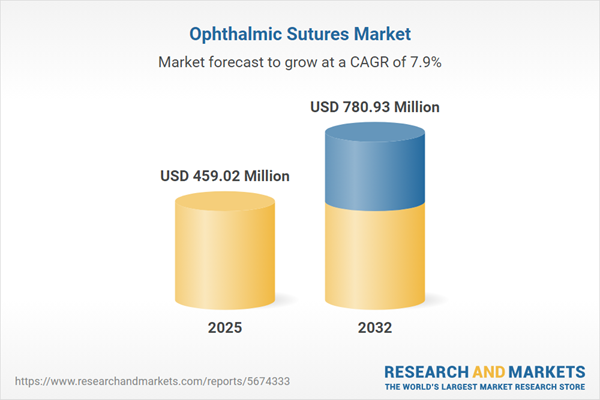Speak directly to the analyst to clarify any post sales queries you may have.
The ophthalmic sutures market is transitioning rapidly as healthcare providers adapt to new procedural standards and operational requirements. Senior decision-makers need actionable insights to respond effectively to evolving clinical demands, regulatory trends, and procurement complexities shaping this specialized sector.
Market Snapshot: Ophthalmic Sutures Market Size and Growth Dynamics
The ophthalmic sutures market reached USD 426.07 million in 2024, with growth projected to USD 459.02 million by 2025 and an expected rise to USD 780.93 million by 2032. This growth reflects a 7.86% compound annual rate, responding to heightened surgical procedure volumes, continued supplier investments, and advances in suture technology. Providers and manufacturers are refining procurement approaches and pursuing regulatory compliance, driven by the need for adaptable solutions in a continuously evolving market landscape.
Scope & Segmentation in the Ophthalmic Sutures Market
- Product Types: Absorbable sutures are utilized where natural tissue repair is preferred, while non-absorbable sutures offer critical support for complex or lengthy ocular procedures.
- Material Choices: Polyamide, polyester, polydioxanone, polyglactin 910, polyglycolic acid, and silk enable compatibility with a wide range of ophthalmic repairs, balancing flexibility and intraoperative adaptability.
- Suture Types: Braided sutures excel in situations demanding robust knot security, whereas monofilament sutures help minimize tissue trauma and are selected for less invasive surgical approaches.
- Applications: Used across cataract, corneal, glaucoma, and intraocular lens procedures, ophthalmic sutures serve routine and intricate eye care interventions.
- End Users: Hospitals and eye care centers focus on product safety and reliability, and ambulatory surgical facilities seek solutions that keep pace with outpatient service growth.
- Suture Sizes: Suture diameters—from ultra-fine 10-0 for pediatric and delicate surgeries to thicker 6-0 for routine repairs—allow teams to select options tailored to procedural needs.
- Regional Markets: Adoption and procurement strategies differ internationally, with the United States, China, India, Germany, Brazil, and Japan emphasizing flexible product portfolios and regionally specific compliance protocols.
- Leading Companies: Ethicon, B. Braun Melsungen AG, Alcon Inc., Teleflex Incorporated, Medtronic plc, Merit Medical Systems, Peters Surgical, Serag-Wiessner, SUTUREMED, and Medical Micro Instruments contribute innovation and expanded capacity to address emerging clinical requirements.
Key Takeaways for Senior Decision-Makers
- Advancements in biodegradable polymer and textile options give providers more choice, enabling alignment with new standards in clinical care and streamlining both complex and routine procedures.
- Collaborations between industry manufacturers and technology developers are promoting greater integration of robotics and augmented reality, supporting precision and procedural efficiency.
- Digital platforms, including blockchain adoption, bolster procurement processes and compliance oversight, supporting transparency and improving management visibility across supply chains.
- Comprehensive, tailored product portfolios designed for variable regional healthcare frameworks and reimbursement settings help organizations remain responsive to market changes.
- Workforce training and enhanced operational protocols accelerate uptake of new surgical tools and promote workflow consistency throughout the clinical team.
Tariff Impact and Procurement Strategies
Recent U.S. tariff adjustments are prompting market participants to reconsider sourcing and distribution channels, prioritizing partnerships and capacity expansion in Asia-Pacific and Middle Eastern regions. Free trade zones within these areas are helping firms manage costs and streamline compliance, reinforcing procurement strategies and improving resilience during periods of sector volatility.
Methodology & Data Sources
This report synthesizes secondary market data, regulatory analyses, and current clinical studies. Direct feedback from surgeons, procurement leaders, and industry executives further ensures the relevance and practical applicability of the findings.
The Ophthalmic Sutures Market: Why This Report Matters
- Detailed segmentation supports executive teams in optimizing supplier partnerships and product portfolios to fit diverse operational and clinical settings.
- Focused procurement and compliance analysis prepares organizations for evolving international regulatory conditions, reducing risk in supplier engagement.
- Strategic recommendations aid in resource planning, helping organizations anticipate and respond to shifts in patient care delivery and market direction.
Conclusion
As innovation reshapes the ophthalmic sutures market, adaptive strategies and proactive operations will enable organizations to advance clinical quality and maintain competitive positioning amid ongoing change.
Additional Product Information:
- Purchase of this report includes 1 year online access with quarterly updates.
- This report can be updated on request. Please contact our Customer Experience team using the Ask a Question widget on our website.
Table of Contents
3. Executive Summary
4. Market Overview
7. Cumulative Impact of Artificial Intelligence 2025
Companies Mentioned
The companies profiled in this Ophthalmic Sutures market report include:- Ethicon, Inc.
- B. Braun Melsungen AG
- Alcon Inc.
- Teleflex Incorporated
- Medtronic PLC
- Merit Medical Systems, Inc.
- Peters Surgical Limited
- Serag-Wiessner GmbH & Co. KG
- SUTUREMED Co., Ltd.
- Medical Micro Instruments, Inc.
Table Information
| Report Attribute | Details |
|---|---|
| No. of Pages | 191 |
| Published | November 2025 |
| Forecast Period | 2025 - 2032 |
| Estimated Market Value ( USD | $ 459.02 Million |
| Forecasted Market Value ( USD | $ 780.93 Million |
| Compound Annual Growth Rate | 7.8% |
| Regions Covered | Global |
| No. of Companies Mentioned | 11 |









